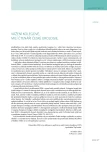Urinary tractinfection after cystectomy with continent orthotopic diversion – Vesica ileale padovana (V.I.P.)
Authors:
Petr Morávek jr. 1; Petr Morávek 1; Miroslav Louda 1; Miloš Broďák 1; Monika Morávková 2
Authors‘ workplace:
Urologická klinika LF UK a FN, Hradec Králové
1; Ústav klinické mikrobiologie LF UK a FN, Hradec Králové
2
Published in:
Ces Urol 2010; 14(3): 173-179
Category:
Original article
Overview
Aim:
The verification of microbial findings in the urine of the patients after a cystectomy with urinary tract reconstruction using ileum and determining sensitivity to antimicrobial drugs and ways of the protection. According to results we plan to propose the appropriate prophylaxis. The suitability of subsequent therapy in postoperative period has been consulted with Department of Clinical Microbiology.
Material and method:
The authors evaluated the cohort of 31 patients after cystectomy with continent derivation of urine in modification Vesica Ileale Padovana (V.I.P.), who underwent surgery on Department of Urology in Hradec Kralove. Quantitative bacteriuria, sensitivity to antimicrobial drugs and efficiency of administered antimicrobial therapy were examined in one, three and six month interval.
Results:
Bacteriuria was present in 35.5 % of patients in the postoperative period. Escherichia coli were the most common finding, sensitive to all common antibiotics. The sensitivity of others microbes as Pseudomonas aeruginosa, Enterococcus faecalis and Klebsiella pneumoniae was only to high generation of cephalosporines, aminoglycosides or another more toxic antibiotics. Despite targeted therapy, bacteriuria was repeatedly positive in 77.4 % of patients, but clinically asymptomatic.
Conclusion:
Quinelones, Trimethoprim + Sulfamethoxazolum or Ampicillin with beta-lactamase inhibitors (i.v.) in combination with metronidazolum one hour before and 7–10 days after operation can be used to cover the serious operation. Asymptomatic bacteriuria is not necessary to treat. In the case of infection with clinical sings of sepsis or pyelonephritis, it is necessary to immediately initiate antibiotic therapy according to the sensitivity to antimicrobial agents.
Key words:
ileal neobladder (V.I.P.), bacteriuria, therapy.
Sources
1. Zbořil, et al. Mikroflora trávicího traktu. Praha: Grada Publishing 2005.
2. Pagano F, Artibani W. Kontinente Ileumblase: Vesica Ileale Padovana (V.I.P.). Akt Urol 1991; 22: I–VI.
3. Mansson W, Davidson T, Konyves J, Liedberg F, Mansson A, Wullt B. Continent urinary tract reconstruction - the Lund experience. BJU Int 2003; 92(3): 271–276.
4. Wullt B, Agace V, Mansson W. Bladder, bowel and bugs – bacteriuria in patiens with intestina urinary diversion. World J Urol 2004; 22 : 186–195.
5. Bonfig R, Gerharz EW, Riedmiller H. Ileal ureteric replacement in complex reconstruction of the urinary tract. BJU Int 2004; 93(4): 575–580.
6. Kristjánsson A, Bajc M, Wallin L, Willner J, Mansson W. Renal function up to 16 years after conduit (refluxing or anti-refluxing anastomosis) or continent urinary diversion Renal scarring and localisation of bacteriuria. Br J Urol 1995; 76(5): 546–550.
7. Madersbacher S, Schmidt J, Berle JM, Thoeny HC, Burkhard F, Hochreiter W, Studer UE. Long-term outcome of ileal conduit diversion. J Urol 2003; 169(3): 985–990.
8. Suriano F, Galluci M, Flammia GP, Musco S, Alcini A, Imbalzano G, Dicoonzo G. Bacteriuria in patients with an orthotopic ileal neobladder: urinary tract infection or asymptomatic bakteriuria? BJU International 2008; 101(12): 1576–1579.
9. Bruce AW, Reid G, Chan RC, Costerton JW. Bacterial adherence in the human ileal conduit: a morphological and bacteriological study. J Urol 1984; 132(1): 184–188. 10. Bishop RF, Smith ED, Gracey M. Bacterial flora of urine from ileal conduit. J Urol 1971; 105(3): 452–455.
11. Chan RC, Reid G, Bruce AW, Costerton JW. Microbial colonisation of human ileal conduits. Appl Environ Microbial 1984 Dec.
12. Keegan SJ, Graham C, Neal DE, Blum-Oehler G, N´Dow J, Pearson JP, Gally DL. Characterization of E. coli strains causing urinary tract infections in patiens with transported intestine segments. J Urol 2003; 169(6): 2382–2387.
13. Hartmann RE, de Petriconi R, Gottfried HW, Kleinschmidt K, Mattes R, Paiss T. The ileal neobladder : complications and functional results in 363 patients after 11years of follouwup. J Urol 1999; 161(2): 422–427; discussion 427–428.
14. Nakano Y, Miyake H, Inoue T, Takenaka A, Hara I, Fujisawa M. Elevated urinary cytokine levels in patients undergoing ileal neobladder replacement compared wirth sigmoid neobladder replacemnet, International Urol and Nephrol 2006; 39(2): 467–472.
15. Akerlund S, Berglund B, Kock NG, Philipson BM. Voiding pattern, urinary volume, composition and bacterial contamination in patiens with urinary diversion via a continet ileal reservoir. Br J Urol 1989; 63(6): 619–623.
16. Fair WR, Couch J, Werner N. Prostated antibacterial factor. Identity and significance Urology 1976; 7 : 169–177.
17. Nicolle LE. Asymptomatic bacteriuria: when to screen and when to treat. Infect Dis Clin North Am 2003; 17(2): 367–394.
18. Akerlund S, Campanello M, Kaijser B, Jonsson O. Bacteriuria in patiens with a continent ileal reservoir for urinary diversion does not regularly require antibiotik treatment. Brit J Urol 1994; 74(2): 177–181.
Labels
Paediatric urologist Nephrology UrologyArticle was published in
Czech Urology

2010 Issue 3
Most read in this issue
- Microsurgical varicocelectomy in children and adolescents: prospective comparison of laparoscopic and open subinguinal repair
- Our experience with shock waves therapy in patiens with Peyronie’s disease (average follow-up of 13 months)
- Position of magnetic resonance and magnetic resonance with spectroscopy in detection of prostate cancer
- Molecular characteristics of clinically significant prostate carcinoma
